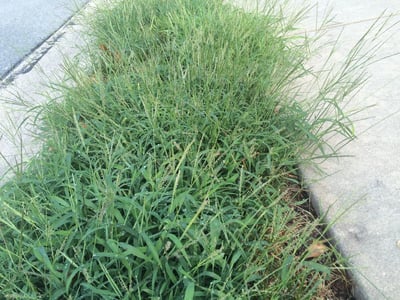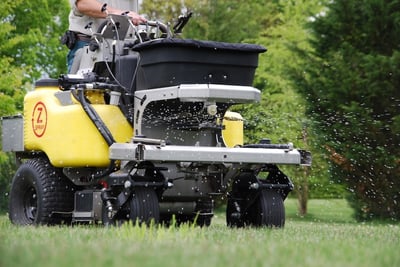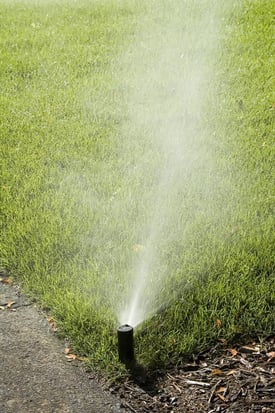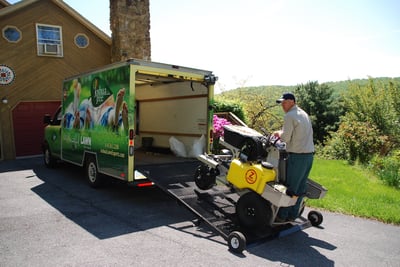 Crabgrass is a menace to your healthy lawn—breaking through in unsightly patches and detracting from an otherwise good-looking yard. Unfortunately, it’s a difficult weed to get rid of, largely because of how quickly it can spread.
Crabgrass is a menace to your healthy lawn—breaking through in unsightly patches and detracting from an otherwise good-looking yard. Unfortunately, it’s a difficult weed to get rid of, largely because of how quickly it can spread.
You may not know that just one crabgrass plant can produce up to 75,000 seeds. These lay dormant in the soil until the ideal conditions for germination rolls around come spring. Then, as crabgrass emerges and grows, it will begin to crowd out your healthy turf in dense, clumping mats throughout your lawn. Because crabgrass is so drought hardy and does not take much to thrive, in little-to-no-time it can really take over a lawn.
Like any homeowner that cares about the health of their lawn, you want to do what you can to prevent crabgrass from invading. However, you may not sure if your DIY approach—or what your lawn care company is doing—is good enough. You may want to know how to get rid of crabgrass so that you can be sure it’s done right.
We know that you don’t feel like doing a ton of research or having to perform your own trial-and-error methods to get crabgrass control right. Let us be your guide to understanding the best ways to get rid of crabgrass.
Here are the six most important tips to remember.
1. Use Crabgrass Preventer
 Taking preventative action by treating proactively is one of the best methods for crabgrass control. Crabgrass preventer works by forming a barrier near the surface of the lawn, which will intercept the germinating crabgrass seeds before they even have a chance to grow. This will prevent the majority of crabgrass from ever growing in the first place.
Taking preventative action by treating proactively is one of the best methods for crabgrass control. Crabgrass preventer works by forming a barrier near the surface of the lawn, which will intercept the germinating crabgrass seeds before they even have a chance to grow. This will prevent the majority of crabgrass from ever growing in the first place.
2. Use Post-Emergent Materials for Breakthrough
Although springtime crabgrass preventer will prevent approximately 80 percent of crabgrass growth, breakthrough can occur—particularly in thinned out areas of the lawn or around edges of your hardscaped areas. For this reason, it’s important to also utilize post-emergent crabgrass control to make sure that any potential breakthrough is addressed throughout the summer.
3. Fertilize Your Lawn for Thickness
Crabgrass is an opportunistic weed that will thrive in any thinned out or bare areas of your lawn that are receiving sunlight. But if you keep your lawn thick and healthy, your turf grass will naturally crowd out crabgrass and prevent it from growing. Fertilizing your lawn throughout the season is a great way to promote thickness.
4. Water Your Lawn Regularly
 Regularly watering your lawn will help keep it vigorous in times of drought, when crabgrass can easily invade. Watering also helps prevent soil from cracking which would destroy the barrier created by crabgrass preventer and open up the area to crabgrass germination.
Regularly watering your lawn will help keep it vigorous in times of drought, when crabgrass can easily invade. Watering also helps prevent soil from cracking which would destroy the barrier created by crabgrass preventer and open up the area to crabgrass germination.
Lawns should receive 1”-2” of water each week. As summer temperatures rise, your lawn’s soil will dry out more quickly, making grass plants weaken enough for crabgrass to break through more easily. Watering 2-3 times per week (for about 45-60 minutes in each area) will help to remedy this issue and keep your lawn strong.
5. Mow Properly
Mowing your grass too short can actually cause the soil to heat up and can create an unfavorable environment for your healthy turfgrass. As your healthy turf thins out, crabgrass will eagerly fill in. Keep your lawn mowed to the ideal height of 3.5 inches, nothing shorter. Also, be careful not to scalp edges when trimming along the driveway or walkways. This is another area where crabgrass will thrive.
6. Aerate and Overseed Your Lawn
Aeration and overseeding each fall will also make a tremendous difference in the overall health and thickness of your lawn, improving its defense against crabgrass. Aeration, which is the process of pulling small cores of soil throughout your lawn, allows more oxygen, water, and nutrients to penetrate deep into the soil and down to the root zone. This is best done at the time of seeding in order to give your grass seeds the best chance at germination.
A Healthy Lawn = Your Best Defense
All six of these steps point to the same thing...a healthy lawn! These are all things that should already be part of a comprehensive lawn care program that will ensure your lawn is performing at its very best. A healthy lawn is the best natural defense against crabgrass.
 If you’re currently taking a DIY approach and you’re noticing crabgrass breakthrough and other issues, it might be time to consider how a professional can take your lawn to the next level. Or, if you’re already using a lawn care company, but you’re not seeing the results you desire, don’t feel that you must continue on the same path. Your service provider might not be doing everything they can to troubleshoot problems and promote a healthy lawn.
If you’re currently taking a DIY approach and you’re noticing crabgrass breakthrough and other issues, it might be time to consider how a professional can take your lawn to the next level. Or, if you’re already using a lawn care company, but you’re not seeing the results you desire, don’t feel that you must continue on the same path. Your service provider might not be doing everything they can to troubleshoot problems and promote a healthy lawn.
You have the power to choose a lawn care service provider that will truly deliver on their promises and that will make a big difference in the effectiveness of your crabgrass control. By making the right choice, you’ll no longer have to worry about trying to figure it out yourself and you’ll no longer have to keep tabs on what your provider is up to. Instead, you’ll have the results you desire—a thriving lawn where crabgrass doesn’t stand a chance.
With the right care for your lawn, you’ll gain valuable peace of mind. If you’re interested in having your lawn inspected and its health assured, contact us for a free quote or give us a call at 833-JTE-TREE.



